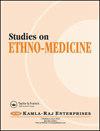Phytochemicals with Health Benefits – Contribution from Brown and White Finger Millet (Eleusine Coracana) Varieties
Q2 Social Sciences
引用次数: 0
Abstract
Bearing in mind that millet market is currently growing, comparison of phytochemicals in two finger millet varieties with different seed coat colours (brown and white) has been carried out. The phytochemicals content was higher in the brown variety when compared to the white variety. Gas chromatography coupled with mass spectrometry (GCMS) analysis revealed the presence of propanamide, 2-butenedioic acid (E)-, diethyl ester, 2-amino-1-(o-hydroxyphenyl) propane, oleic acid, propan-1-one, 2-amino-1-piperidin-1-yl-, hexanedioic acid, bis (2-ethylhexyl) ester, guanidine, N,N,N’,N’-tetramethyl-, limonene, phthalic acid, 2-cyclohexylethyl butyl ester, actinobolin, n-hexadecanoic acid, 9,12-octadecadienoic acid (Z,Z)-, cyanoacetyl urea, tetracosane, fluoxetine and arginine in the finger millet grains. Phytochemicals are known to have antioxidant activity, and analysis by DPPH assay showed 85.77 percent in the brown variety and 62.18 percent in the white variety. Further studies are needed to isolate active compounds of the extract and correlate structural function relationships in order to propose their exact mechanism of action in various disorders. *Address for correspondence: Dr. Usha Antony Centre for Food Technology, Department of Biotechnology, Anna University, Chennai 600 025, Tamilnadu, India Phone: +914422358379, Fax: +914422350299, E-mail: twinkle19872001@yahoo.co.in INTRODUCTION Since earlier times, natural products have been used for maintaining health, with more intensive studies for natural therapies especially in the last decade. Traditional medicine is used by almost eighty percent of the population (Eloff 1998). Currently, there is an increased interest among consumers regarding the role of food in maintaining and improving human well-being. Foods are also known to contain bioactive components with therapeutic effects. Plants extracts are sources of antihypertensive, hypoglycaemic, hypolipidaemic, anti-inflammatory and antibiotic compounds. Therefore, such foods need be investigated to better understand their properties and efficiency. Millets are important components of a healthy diet, and their daily consumption could prevent cardiovascular diseases and certain cancers (Bhupathiraju and Tucker 2011). These beneficial effects of millets have been attributed to non-essential food constituents, known as phytochemicals or bioactive compounds, which have a relevant bioactivity when they are frequently consumed as a part of a regular diet (Mudgal et al. 2010). Millets are ranked sixth in the world for cereal production, and they are the major food source for people living with economically disadvantaged status in Africa and Asia (Kumari et具有健康益处的植物化学物质——褐指和白指小米(Eleusine Coracana)品种的贡献
考虑到小米市场目前正在增长,我们对具有不同种皮颜色(棕色和白色)的两指小米品种的植物化学物质进行了比较。与白色品种相比,棕色品种的植物化学物质含量更高。气相色谱-质谱联用(GCMS)分析显示存在丙酰胺、2-丁烯二酸(E)-、二乙酯、2-氨基-1-(邻羟基苯基)丙烷、油酸、丙-1-酮、2-氨基1-哌啶-1-基、己二酸、双(2-乙基己基)酯、胍、N,N,N’,指谷中的正十六烷酸、9,12-十八碳二烯酸(Z,Z)-、氰基乙酰脲、丁烷、氟西汀和精氨酸。已知植物化学物质具有抗氧化活性,DPPH分析显示,棕色品种的抗氧化活性为85.77%,白色品种为62.18%。需要进一步的研究来分离提取物的活性化合物并关联结构-功能关系,以便提出它们在各种疾病中的确切作用机制*通信地址:印度塔米尔纳杜金奈600 025安娜大学生物技术系Usha Antony博士食品技术中心电话:+91422358779,传真:+914223350299,电子邮件:twinkle19872001@yahoo.co.in引言自早期以来,天然产品一直被用于维持健康,尤其是在过去十年中,对天然疗法进行了更深入的研究。近80%的人口使用传统医学(Eloff,1998年)。目前,消费者对食品在维护和改善人类福祉方面的作用越来越感兴趣。众所周知,食品中含有具有治疗作用的生物活性成分。植物提取物是抗高血压、低血糖、降血脂、抗炎和抗生素化合物的来源。因此,需要对此类食品进行调查,以更好地了解其特性和功效。小米是健康饮食的重要组成部分,每天食用小米可以预防心血管疾病和某些癌症(Bhupathiraju和Tucker,2011年)。小米的这些有益作用被归因于非必需的食物成分,即植物化学物质或生物活性化合物,当它们作为日常饮食的一部分经常食用时,它们具有相关的生物活性(Mudgal等人,2010)。小米在谷物生产方面排名世界第六,是非洲和亚洲经济弱势群体的主要食物来源(Kumari et
本文章由计算机程序翻译,如有差异,请以英文原文为准。
求助全文
约1分钟内获得全文
求助全文
来源期刊

Studies on Ethno-Medicine
Social Sciences-Cultural Studies
CiteScore
0.50
自引率
0.00%
发文量
13
期刊介绍:
Studies on Ethno-Medicine is a peer reviewed, internationally circulated journal. It publishes reports of original research, theoretical articles, timely reviews, brief communications, book reviews and other publications in the interdisciplinary field of ethno-medicine. The journal serves as a forum for physical, social and life scientists as well as for health professionals. The transdisciplinary areas covered by this journal include, but are not limited to, Physical Sciences, Anthropology, Sociology, Geography, Life Sciences, Environmental Sciences, Botany, Agriculture, Home Science, Zoology, Genetics, Biology, Medical Sciences, Public Health, Demography and Epidemiology. The journal publishes basic, applied and methodologically oriented research from all such areas. The journal is committed to prompt review, and priority publication is given to manuscripts with novel or timely findings, and to manuscript of unusual interest. Further, the manuscripts are categorised under three types, namely - Regular articles, Short Communications and Reviews. The researchers are invited to submit original papers in English (papers published elsewhere or under consideration elsewhere shall not be considered).
 求助内容:
求助内容: 应助结果提醒方式:
应助结果提醒方式:


